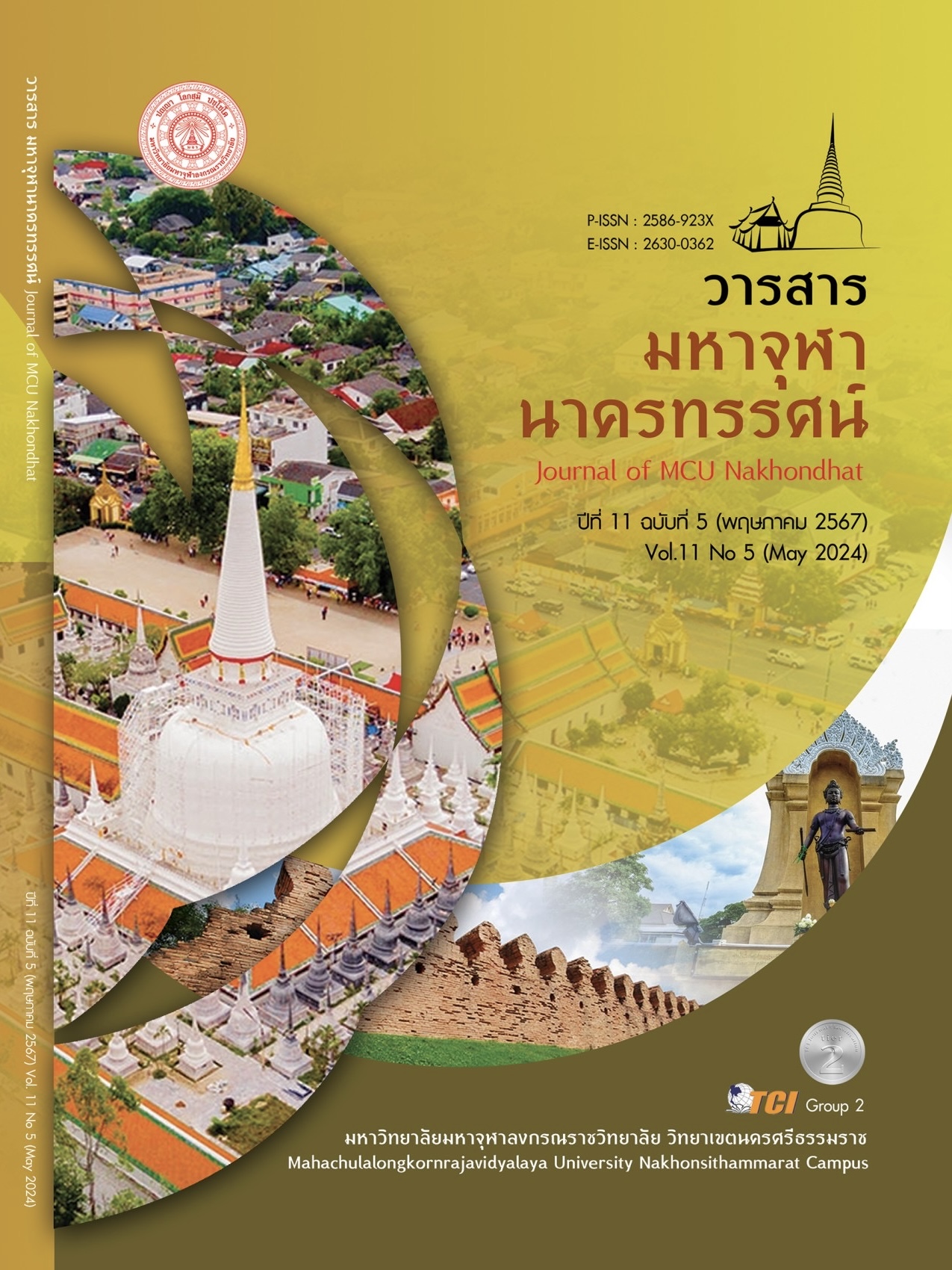MAINTAINING THE VALUE OF THAI ARTS AND CULTURE BASED ON BUDDHISM
Main Article Content
Abstract
Cultural capital is intellectual property accumulated in the past. It is valuable to humans and the needs of society. In addition to providing economic value, it is capital used to produce goods and services that have cultural meaning. which is financial capital Service capital in capitalism Today's world is connected to an industry that carries cultural connotations called Product industry A culture that produces cultural goods and services that has culture embedded in the goods and services. Culture helps create order in society. It determines the behavior patterns of members of society. Including creating a pattern of thoughts, beliefs, and values of members in the same format. Helps create unity. A society that has the same culture will have a feeling of connection. Solidarity arose. Dedicated to society Culture determines the shape of the family institution. It is a symbol of national identity. A nation with a high culture It would be praised and a guarantee of national security. Help the country progress If any society has a good and appropriate culture, such as discipline, diligence, patience, and seeing the common good more than the individual. Society will be able to progress. Therefore, the value of preserving Buddhist arts and culture in Thai society today must be preserved. Taking into account the participation of the community in maintaining and developing the arts of the temple. Art in Buddhism is usually created in temples. This is because the temple is the center of Buddhism. Conveying art and Dharma Invite to enter the temple It is a vehicle for perception and understanding of Dhamma principles. Have a mind of merit, be charitable, sacrifice, make donations. Buddhist arts produce results that are of mental value. For those interested in arts and culture
Article Details

This work is licensed under a Creative Commons Attribution-NonCommercial-NoDerivatives 4.0 International License.
References
กรมศิลปกร. (2544). คู่มือถวายความรู้แด่พระสังฆาธิการในการดูแลรักษามรดกทางศิลปวัฒนธรรม. (พิมพ์ครั้งที่ 3). กรุงเทพมหานคร: บริษัทสมานพันธ์ จำกัด.
คณะกรรมการดำเนินงานและประสานงานวันอนุรักษ์มรดกไทย. (2541). แผนแม่บทวันอนุรักษ์มรดกไทย. เรียกใช้เมื่อ 16 เมษายน 2567 จาก https://www2.m-culture.go.th/
คณาจารย์มหาวิทยาลัยมหาจุฬาลงกรณราชวิทยาลัย. (2551). วัฒนธรรมไทย. กรุงเทพมหานคร: โรงพิมพ์มหาจุฬาลงกรณราชวิทยาลัย.
ประเวศ วะสี. (2544). การพัฒนาการท่องเที่ยวอย่างยั่งยืน. จุลสารการท่องเที่ยว, 20(3), 33-41.
ประเวศ อินทองปาน. (2560). การธำรงวัฒนธรรมไทยที่มีรากฐานจากพระพุทธศาสนา. วารสารมหาจุฬาวิชาการ, 3(1), 68-85.
เปี่ยม บุญยะโชติ. (2513). การสร้างโบสถ์และอานิสงส์การสร้างประมวลหลักโหราศาสตร์และมูลเหตุของศาสตร์และพิธีกรรมของโหร. กรุงเทพมหานคร: โรงพิมพ์เฟื่องอักษร.
ผจงจิตต์ อธิคมนันทะ. (2543). การเปลี่ยนแปลงสังคมและวัฒนธรรมไทย. กรุงเทพมหานคร: มหาวิทยาลัยรามคำแหง.
พระธรรมวรนายก (โอภาส นิรุตฺติเมธี). (2546). การพัฒนาวัดให้เป็นศูนย์กลางของชุมชนในธรรมปริทัศน์ 46. กรุงเทพมหานคร: โรงพิมพ์มหาจุฬาลงกรณราชวิทยาลัย.
พระยาอนุมานราชธน. (2533). เรื่องพระเจดีย์. กรุงเทพมหานคร: โรงพิมพ์พระจันทร์.
พระราชพงศาวดารกรุงศรีอยุธยา ฉบับพระเจ้าจักรวรรดิพงศ์. (2533). (จาด) เล่ม 2. กรุงเทพมหานคร: โรงพิมพ์คุรุสภา.
ราชบัณฑิตยสถาน . (2530). พจนานุกรมศัพท์ศิลปกรรม อักษร ข-ฉ. กรุงเทพมหานคร: บริษัทเพื่อนพิมพ์.
วิจิตร สินสิริ และนิล เอี่ยมสำอาง. (2530). แบบฝึกหัดรวบยอด ส. 102 ประเทศของเรา สำหรับชั้นมัธยมศึกษาปีที่ 1. กรุงเทพมหานคร: อักษรเจริญทัศน์.
สถาบันพระปกเกล้า. (2550). วัดระดับการบริหารจัดการที่ดี. (พิมพ์ครั้งที่ 3). นนทบุรี: บริษัท พิมพ์ดี จำกัด.
สมเด็จพระเจ้าบรมวงศ์เธอ เจ้าฟ้ากรมพระยานริศรานุวัดติวงศ์ และสมเด็จพระเจ้าบรมวงศ์เธอ กรมพระยาดำรงราชนุภาพ. (2551). สาส์นสมเด็จ (เล่ม 2). กรุงเทพมหานคร: โรงพิมพ์คุรุสภา.
สมเด็จพระมหาสมณเจ้ากรมพระยาวชิรญาณวโรรส. (2531). วินัยมุข เล่ม 1 (พิมพ์ครั้งที่ 35). กรุงเทพมหานคร: โรงพิมพ์มหามกุฏราชวิทยาลัย.
สำนักงานคณะกรรมการจัดระบบจราจรทางบก. (2541). เศรษฐกิจพอเพียงและประชาสังคมแนวทางพลิกฟื้นเศรษฐกิจสังคม. กรุงเทพมหานคร: โรงพิมพ์หมอชาวบ้าน.
สำนักงานคณะกรรมการสิ่งแวดล้อมแห่งชาติ. (2530). การพัฒนาการอนุรักษ์สิ่งแวดล้อมศิลปกรรม. กรุงเทพมหานคร: โรงพิมพ์การศาสนา.
สำนักงานพระพุทธศาสนา. (2567). พระพุทธศาสนากับวัฒนธรรมไทย. เรียกใช้เมื่อ 7 เมษายน 2567 จาก https://www.mcu.ac.th/article/detail/405
สุรสวัสดิ์ สุขสวัสดิ์. (2542). การอนุรักษ์ศิลปกรรมเชียงใหม่. เชียงใหม่: มหาวิทยาลัยเชียงใหม่.


